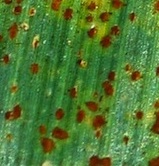University of Georgia Cooperative Extension plant pathologist Bob Kemerait cautions Georgia corn farmers about the El Nino weather pattern that will likely interfere with planting this March. A delay would increase the likelihood of diseases too, so Kemerait advises growers to plant resistant varieties and be ready to apply fungicides earlier than normal.
A wet winter has already saturated Georgia’s soils, and more wet and cool conditions are expected through the first part of spring, according to UGA agricultural climatologist Pam Knox. “The rains associated with passing storms will keep soils wet for the foreseeable future,” she said.
Since Georgia corn producers typically begin planting in early to mid-March, extremely wet conditions could make it impossible to get in the fields.
“When I’m talking to corn growers at our winter meetings, first and foremost on my mind is the expectation that we could see delays in planted corn. Farmers need to realize how much that is going to impact them,” Kemerait said.
Later-planted corn runs a higher risk of disease than early-planted corn. Diseases such as southern corn rust and northern corn leaf blight concern Kemerait the most.
“Diseases will take a larger percentage of your yield on later-planted corn if you don’t manage it,” Kemerait said. “If southern corn rust comes early enough, and we don’t protect against it, it can take out an average of 80 bushels per acre. With northern corn leaf blight, if (the crop’s) not protected, we’re probably looking at a loss of 25 to 30 bushels per acre, maybe more.”
While southern rust is not in Georgia now, Kemerait said it could move north from Florida, either by impending storms in the weeks ahead or by wind currents from the south.
Two years ago, southern rust was a major problem in Georgia. The disease infects the corn leaves; then, the leaves can’t produce the sugars produced through photosynthesis, which are the plant's energy source. This results in yield loss. Also, the corn stalk can be drained of its strength, making plants vulnerable during high winds, which could blow the stalks down.
“The later you plant, the greater chance you have that corn rust is going to be introduced when the corn is at a critical stage of growth,” Kemerait said. “Once some corn is infected, it continues to re-infect it, so you increase your inoculum level. You increase the spore load. The later you plant, almost certainly it’s going to increase the risk.”
Early wet conditions would be favorable for diseases like northern corn leaf blight – already in fields and surviving in debris – to be reintroduced, according to Kemerait.
“My expectation now is that diseases will be more important in 2016 than they generally are. Why will that be? Delays in planting; rust perhaps surviving as close as southern Florida because of warmer temperatures, so it won’t have to travel as far and conditions are favorable for northern corn leaf blight,” Kemerait said. “It’s better for corn growers to be proactive instead of reactive when dealing with these two diseases.”
While corn growers should be on alert, a delay in planting will impact other crops, too. Other commodities, like cotton, will be delayed because growers are trying to get corn seed in the ground.
El Nino has a more drastic effect on corn crops in countries like South Africa, where people rely on corn as a major source of food, said UGA agronomist Ian Flitcroft, director of the Georgia Automated Environmental Monitoring Network.
“El Nino is causing a global food crisis. It may be wetter here in Georgia, but it doesn’t rain everywhere. El Nino events cause severe droughts in places like South Africa,” he said.
Unlike Georgia farmers, these growers often don’t have irrigation systems, and crops may depend solely on rainfall. When the rain doesn’t come, the crops don’t grow.
“That’s what is happening with their maize crop, and millions of people are in need of food aid,” Flitcroft said. “Farmers there plant when the rains come, and if the rains don’t come, they are in an emergency food situation.”







